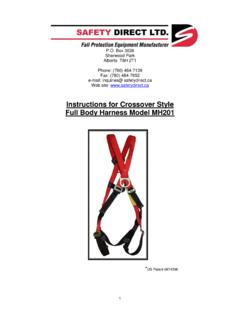Transcription of APPENDIX 8 EUROPEAN STANDARDS AND MARKINGS FOR …
1 APPENDIX 8 EUROPEAN STANDARDS AND MARKINGS FOR BUOYANCY, IMMERSION AND DIVING SUITS ISSUE 8: January 2013 This information is extracted from British STANDARDS with the permission of BSI under licence number PD\1998 1367 INTRODUCTION Harmonised EUROPEAN STANDARDS for Personal Protective Equipment (PPE) have beendeveloped as the preferred means of demonstrating equipment conformity with the basic health and safety requirements (BHSRs) of the EC Personal Protective EquipmentDirective (89/686/EEC). Only equipment which meets these BHSRs is entitled to carry theCE mark and to be sold for use in the EC. The alternative route to obtaining the CE mark involves the manufacturer producing a'technical file' for the equipment which also demonstrates that it satisfies the BHSRs.
2 Insuch cases, the equipment will carry the CE mark but may not display any Standardnumber. The manufacturer's information will contain the performance specification. For Category III PPE (for use against mortal danger ), the CE mark will be accompaniedby a four-digit code number identifying the responsible Notified Body appointed to ensurethat the manufactured product continues to satisfy the BHSRs. Increasingly, EUROPEAN STANDARDS (prefixed EN EUROPEAN Norm) are being superseded or subsumed by International STANDARDS (prefixed ISO). Where these are adopted in theUK, they will also be issued as British STANDARDS and be prefixed BS.
3 The British versionsof STANDARDS (BS EN, BS ISO or BS EN ISO) may have minor differences from the originalversions of the standard, usually in the form of a National Foreword or National Annex, toaccount for legislative or technical variations specific to the UK. If such a UK variationexists, this is flagged up in the attached listings below for the individual STANDARDS . BSversions may also differ slightly in the stated year of issue from the EN or ISO versions;the original EN or ISO issue dates are quoted here. The STANDARDS may contain design, performance and marking requirements for thedifferent types of equipment.
4 This document lists the STANDARDS , and gives a briefexplanation of the MARKINGS which they define. ORGANISATION OF THE INFORMATION PPE STANDARDS are separated into broad categories, depending on the type of protectionintended, eg head protection, foot protection. Separate documents have been producedfor each category. Within a category, where possible, STANDARDS have been further subdivided according tothe hazard (eg mechanical hazards, heat and flame) or component type (eg filters;facepieces) as appropriate. Both current and recently superseded versions are listed, asequipment marked according to either version may be encountered in the field.
5 Standard number and date are given, with the title (sometimes abridged). If a UK National variation applies to this standard, the nature of this variation is and classifications defined in the Standard for that class of equipment are listedand briefly described. Related STANDARDS , eg specific test methods which will not usually appear in the markingson equipment are listed separately at the end of each document. Pictograms and symbols for each type of equipment are included at the rear of the relevant document. STANDARDS FOR BUOYANCY, IMMERSION AND DIVING SUITS Buoyancy EN 393:1993- Lifejackets and personal buoyancy aids. Buoyancy aid 50 Superseded by EN ISO 12402-5:2006 Basic text identifying manufacturer, model, size, limitations, donning and maintenance instructions, month or quarter and year of manufacture, Standard number, and completed label in Figure 1.
6 Plus: - BUOYANCY AID 50 and/or pictogram (Figure 2) - DO NOT USE AS A CUSHION - FOR THOSE WHO CAN SWIM AND ARE CLOSE TO HELP If in colour, text table and pictogram should be RED EN 394:1993 - Lifejackets and personal buoyancy aids. Additional items Superseded by EN ISO 12402-8:2006 and SOLAS Emergency lights A - 'all round light' type B - 'lens dome light' type Also covered: whistles, multi-chamber buoyancy aids, safety harness and lines, body lines, sprayhoods, protective covers. EN 395:1993 - Lifejackets and personal buoyancy aids. Lifejacket 100 Superseded by EN ISO 12402-4:2006 Basic text as for EN 393, plus: - LIFEJACKET 100 and/or pictogram (Figure 3) - DO NOT USE AS A CUSHION - TEACH THE CHILD TO FLOAT IN THIS LIFEJACKET (if intended for use by children under 40kg) - FULL PERFORMANCE MAY NOT BE ACHIEVED USING CERTAIN CLOTHING OR IN OTHER CIRCUMSTANCES.
7 REFER TO THE LEAFLET If in colour, text table and pictogram should be YELLOW EN 396:1993 - Lifejackets and personal buoyancy aids. Lifejacket 150 Superseded by EN ISO 12402-3:2006 Basic text as for EN 393. Additional text as for EN 395 except: - LIFEJACKET 150 and/or pictogram (Figure 4) If in colour, text table and pictogram should be GREEN EN 399:1994 - Lifejackets and personal buoyancy aids. Lifejacket 275 Superseded by EN ISO 12402-2:2006 Basic text as for EN 393. Additional text as for EN 395 except: - LIFEJACKET 275 and/or pictogram (Figure 5) If in colour, text table and pictogram should be BLUE EN ISO 12402-1:2005 Lifejackets for seagoing ships Safety Requirements - Manufacturer identification - Size range of intended wearer plus symbol for adult, child or infant - Approval information - Model and serial numbers - Month (numeral1-12_ or Quarter (I IV) and year of manufacture - Date of servicing.)
8 And Annual servicing required for inflatable devices - upper height/weight limits Additionally for crew lifejackets: - Minimum buoyancy and inflatable buoyancy (if provided) - Brief storage care and cleaning instructions - Simple use, donning and adjustment instructions - If gas inflated, the correct size and charge of cylinder - Warning that gas cylinders are dangerous goods - Words / pictograms for other risks - Do not use as a cushion - Train in the use of this PFD - Compatibility with safety harnesses and clothing - Trapped air and carried load impair the performance EN ISO 12402-2:2006 Personal flotation devices Part 2: Lifejackets, performance level 275 - Safety Requirements Amended 2010 - Manufacturer identification - Class of the PFD (275) - Statement that it is not a PFD until inflated (inflatable types) - Size range of intended wearer - Minimum buoyancy and inflatable buoyancy (if provided) - Brief storage care and cleaning instructions - Simple use, donning and adjustment instructions - If gas inflated, the correct size and charge of cylinder - Warning that gas cylinders are dangerous goods, keep away from children, do not misuse - Model and serial numbers - Month (numeral 1-12) or Quarter (I IV)
9 And year of manufacture - This standard and part number (ISO 12402-2) - Words / pictograms for other risks - Do not use as a cushion - Train yourself in the use of this PFD - Teach the child to float in this PFD if intended for use by children - For children less than 6 years of age use automatically operating devices only if relevant - the range of its specific application (corresponding to class) - expected servicing interval assuming average use; space for dates to be marked (including for components) - Compatibility with safety harnesses and clothing - Full performance may not be achieved using waterproof clothing or in other circumstances.
10 Refer to leaflet - Warning: Do not apply diapers which provide buoyancy when using the lifejacket (For users up to 15kg) - Label (Figure 6 or 7) and/or pictogram (Figure 5) Optional colour code for relevant text / pictogram blue EN ISO 12402-3:2006 Personal flotation devices Part 3: Lifejackets, performance level 150 - Safety Requirements Amended 2010 As for ISO 12402-2 except: - Class of the PFD (150) - This standard and part number (ISO 12402-3) - Label (Figure 6 or 7) and/or pictogram (Figure 4) Optional colour code for relevant text / pictogram turquoise EN ISO 12402-4:2006 Personal flotation devices Part 4: Lifejackets, performance level 100 - Safety Requirements Amended 2010 As for ISO 12402-2 except: - Class of the PFD (100) - This standard and part number (ISO 12402-4) - Label (Figure 6 or 7) and/or pictogram (Figure 3) Optional colour code for relevant text / pictogram light brown EN ISO 12402-5:2006 Personal flotation devices Part 5: Buoyancy aids (level 50) - Safety Requirements Corrected 2006, Amended 2010 As for ISO 12402-2 except: - Class of the PFD (50) - This standard and part number (ISO 12402-5) - Label (Figure 6 or 7) and/or pictogram (Figure 2) Optional colour code for relevant text / pictogram pink EN ISO 12402-6.














